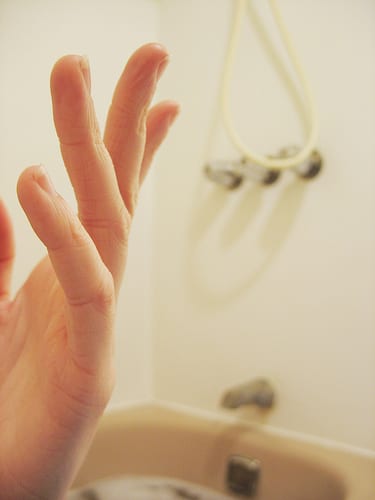At one time or another, most of us have experienced “pruney” fingers, or the exaggerated wrinkling of fingers and toes that results from prolonged exposure to water. Until the early twentieth century, most scientists attributed the pruney fingers phenomenon to osmosis, or the movement of water into dry outer layers of the skin. This movement of water was thought to puff up the skin covering the tips of hands and feet. Such action expands the skin’s surface area, and was assumed to lead to the visible wrinkling of skin in fingers and toes (1).
In the 1930s, however, researchers realized that patients with fingertip nerve damage failed to experience the same pruney effects (1). It has since become apparent that the wrinkling of skin associated with exposure to water is due in larger part to the function of the nervous system than to osmosis (2).
In fact, the primary mechanism that contributes to the shriveling of skin in response to water is vasoconstriction, the shrinkage of blood vessels under the epidermis. In response to water, the nervous system restricts blood flow to the fingertips. The resulting loss of volume in each finger causes the skin to shrink inward, forming the wrinkles we associate with “pruney” fingers (3).
But why would the brain automatically signal wet skin to shrivel up? Moreover, why does this effect only involve the tips of fingers and toes?
In 2011, evolutionary neurobiologist Mark Changizi proposed a now widely accepted theory regarding the cause of finger and toe wrinkling in response to water. Changizi suggested that human ancestors evolved this behavior in order to get a better grip with their hands and feet under wet conditions. According to Changizi, the wrinkles in the skin act like car tire threads, channeling water out of the way and allowing fingers and toes to grasp more effectively (3). Experiments that compare the gripping ability of wrinkled fingers and normal fingers on slippery objects, such as wet marbles, confirm Changizi’s explanation(1). The ability to better maintain grip in wet conditions could give human ancestors a competitive advantage, especially in particularly wet climates.
References
- B. Summers, Why Do Our Fingers Wrinkle During a Bath? (2013) Available at http://www.scientificamerican.com/article.cfm?id=why-do-our-fingers-and-toes-wrinkle-during-a-bath
- J. Hamblin, Why We Get Prune Fingers. (2013) Available at http://www.theatlantic.com/health/archive/2013/01/why-we-get-prune-fingers/266980/
- Getting a Handle on Why Fingers Wrinkle. (2013) Available at http://www.npr.org/2013/01/11/169144851/getting-a-handle-on-why-fingers-wrinkle

Taluh
Why does this happen in fresh water but not in salt water? Thank you.